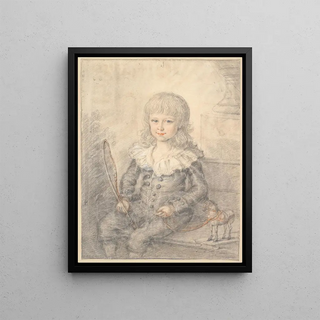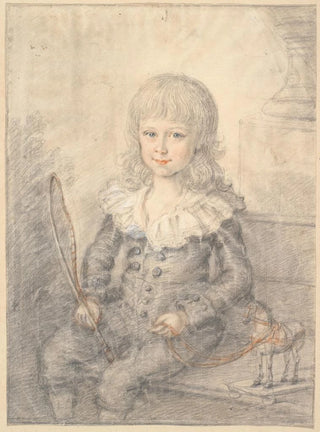Art print | Portrait of a boy with a stuffed horse - Jens Juel


View from behind

Frame (optional)
In the vast panorama of art history, certain works stand out for their ability to capture the innocence and tenderness of childhood. "Portrait of a Boy with a Teddy Bear" by Jens Juel is one of those creations that evoke a world of softness and nostalgia. This painting, imbued with a delicate atmosphere, transports the viewer into a universe where the simplicity of everyday objects transforms into a celebration of childhood. Through the gaze of the young boy, Juel invites us to rediscover the magic of childhood memories, while reminding us of the importance of emotional bonds woven around these precious moments.
Style and uniqueness of the work
Jens Juel's style is characterized by an intimate and realistic approach that defines his portraits. In "Portrait of a Boy with a Teddy Bear," light plays a fundamental role, illuminating the boy's face and creating a subtle contrast between shadows and highlights. The meticulous details of the face, clothing, and teddy bear demonstrate exceptional craftsmanship, while the palette of soft and warm colors enhances the emotion conveyed by the piece. Juel manages to infuse a soul into his subject, making the viewer a confidant of this tender and authentic scene. The boy's expression, both dreamy and focused, evokes a psychological depth that invites reflection on themes of childhood, solitude, and imagination.
The artist and his influence
Jens Juel, Danish painter of the 18th century, managed to carve out a prominent place in the art world thanks to his talent for capturing the psychology of his subjects. Influenced by neoclassical currents and portraiture, he combined technical rigor with sensitivity. His works, often focused on portraits of families and children, reveal a deep understanding of human relationships. Juel was also a pioneer in the art of children's portraiture, a field often neglected by his contemporaries. His legacy endures through the centuries, inspiring many artists who, like him, seek to explore the complexity

Matte finish

View from behind

Frame (optional)
In the vast panorama of art history, certain works stand out for their ability to capture the innocence and tenderness of childhood. "Portrait of a Boy with a Teddy Bear" by Jens Juel is one of those creations that evoke a world of softness and nostalgia. This painting, imbued with a delicate atmosphere, transports the viewer into a universe where the simplicity of everyday objects transforms into a celebration of childhood. Through the gaze of the young boy, Juel invites us to rediscover the magic of childhood memories, while reminding us of the importance of emotional bonds woven around these precious moments.
Style and uniqueness of the work
Jens Juel's style is characterized by an intimate and realistic approach that defines his portraits. In "Portrait of a Boy with a Teddy Bear," light plays a fundamental role, illuminating the boy's face and creating a subtle contrast between shadows and highlights. The meticulous details of the face, clothing, and teddy bear demonstrate exceptional craftsmanship, while the palette of soft and warm colors enhances the emotion conveyed by the piece. Juel manages to infuse a soul into his subject, making the viewer a confidant of this tender and authentic scene. The boy's expression, both dreamy and focused, evokes a psychological depth that invites reflection on themes of childhood, solitude, and imagination.
The artist and his influence
Jens Juel, Danish painter of the 18th century, managed to carve out a prominent place in the art world thanks to his talent for capturing the psychology of his subjects. Influenced by neoclassical currents and portraiture, he combined technical rigor with sensitivity. His works, often focused on portraits of families and children, reveal a deep understanding of human relationships. Juel was also a pioneer in the art of children's portraiture, a field often neglected by his contemporaries. His legacy endures through the centuries, inspiring many artists who, like him, seek to explore the complexity






